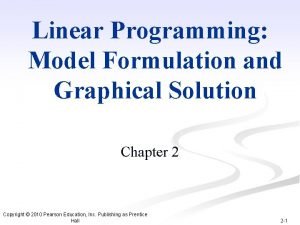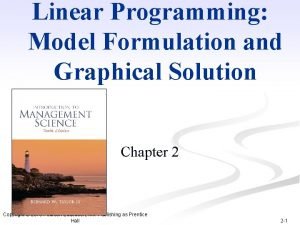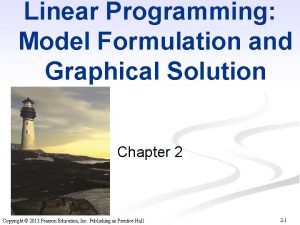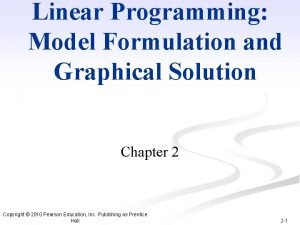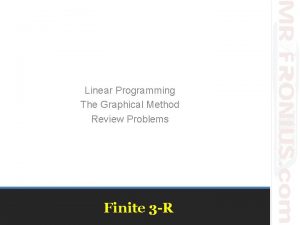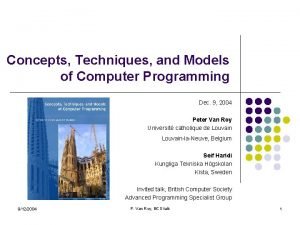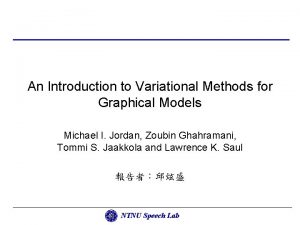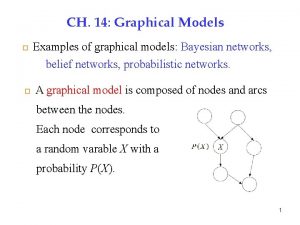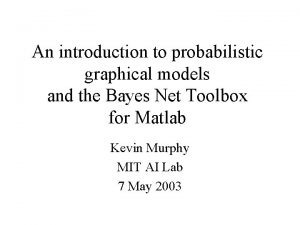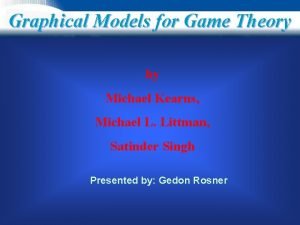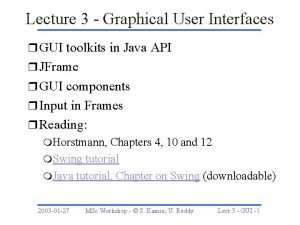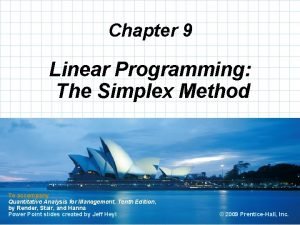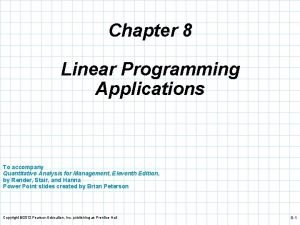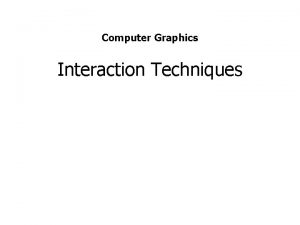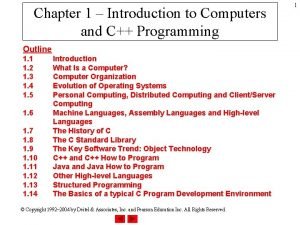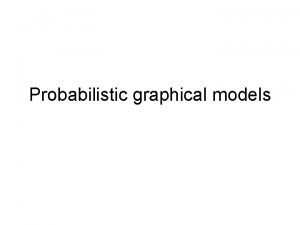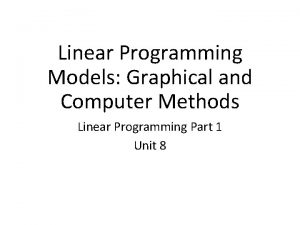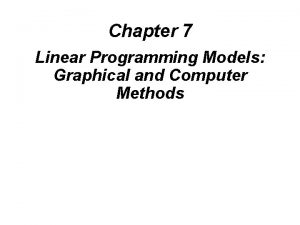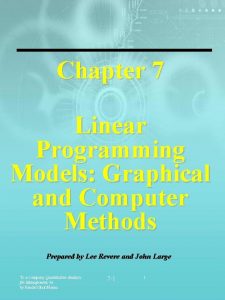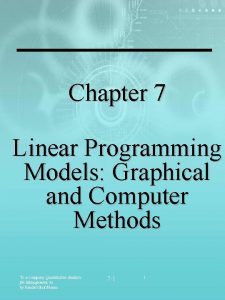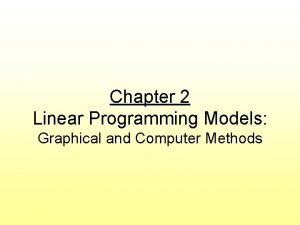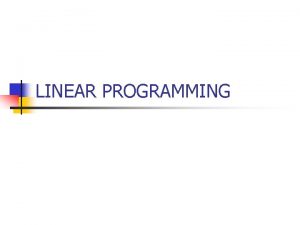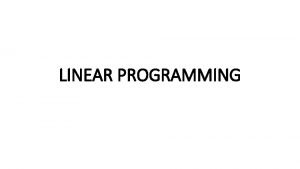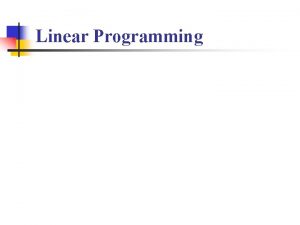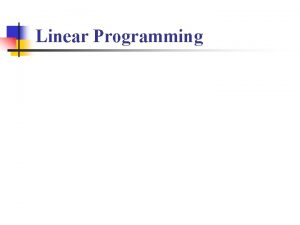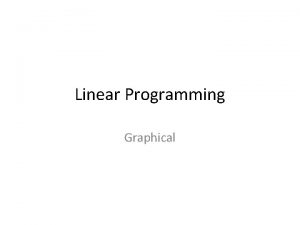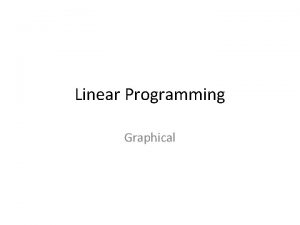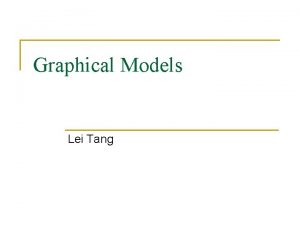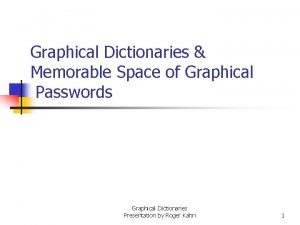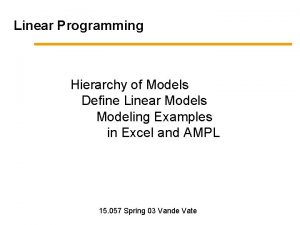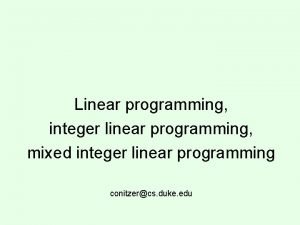Chapter 2 Linear Programming Models Graphical and Computer






















- Slides: 22

Chapter 2 Linear Programming Models: Graphical and Computer Methods © 2007 Pearson Education

Steps in Developing a Linear Programming (LP) Model 1) Formulation 2) Solution 3) Interpretation and Sensitivity Analysis

Properties of LP Models 1) Seek to minimize or maximize 2) Include “constraints” or limitations 3) There must be alternatives available 4) All equations are linear

Example LP Model Formulation: The Product Mix Problem Decision: How much to make of > 2 products? Objective: Maximize profit Constraints: Limited resources

Example: Flair Furniture Co. Two products: Chairs and Tables Decision: How many of each to make this month? Objective: Maximize profit

Flair Furniture Co. Data Tables Chairs (per table) (per chair) Profit Contribution $7 $5 Hours Available Carpentry 3 hrs 4 hrs 2400 Painting 2 hrs 1 hr 1000 Other Limitations: • Make no more than 450 chairs • Make at least 100 tables

Decision Variables: T = Num. of tables to make C = Num. of chairs to make Objective Function: Maximize Profit Maximize $7 T + $5 C

Constraints: • Have 2400 hours of carpentry time available 3 T + 4 C < 2400 (hours) • Have 1000 hours of painting time available 2 T + 1 C < 1000 (hours)

More Constraints: • Make no more than 450 chairs C < 450 (num. chairs) • Make at least 100 tables T > 100 (num. tables) Nonnegativity: Cannot make a negative number of chairs or tables T>0 C>0

Model Summary Max 7 T + 5 C (profit) Subject to the constraints: 3 T + 4 C < 2400 (carpentry hrs) 2 T + 1 C < 1000 (painting hrs) T C < 450 (max # chairs) > 100 (min # tables) T, C > 0 (nonnegativity)

Graphical Solution • Graphing an LP model helps provide insight into LP models and their solutions. • While this can only be done in two dimensions, the same properties apply to all LP models and solutions.

Carpentry Constraint Line C 3 T + 4 C = 2400 Infeasible > 2400 hrs 600 3 T Intercepts (T = 0, C = 600) (T = 800, C = 0) + 4 C = Feasible < 2400 hrs 24 00 0 0 800 T

C= +1 2 T + 1 C = 1000 2 T Painting Constraint Line C 1000 600 00 10 Intercepts (T = 0, C = 1000) (T = 500, C = 0) 0 0 500 800 T

Max Chair Line C 1000 C = 450 Min Table Line 600 450 T = 100 Feasible 0 Region 0 100 500 800 T

7 T C C 4, 0 =$ 500 40 7 T + 5 C = Profit +5 Objective Function Line 7 T 400 Optimal Point (T = 320, C = 360) C +5 C 00 +5 2, 8 =$ 7 T 300 =$ 00 2, 1 200 100 0 0 100 200 300 400 500 T

C Additional Constraint Need at least 75 more chairs than tables New optimal point T = 300, C = 375 500 400 T = 320 C = 360 No longer feasible C > T + 75 Or C – T > 75 300 200 100 0 0 100 200 300 400 500 T

LP Characteristics • Feasible Region: The set of points that satisfies all constraints • Corner Point Property: An optimal solution must lie at one or more corner points • Optimal Solution: The corner point with the best objective function value is optimal

Special Situation in LP 1. Redundant Constraints - do not affect the feasible region Example: x < 10 x < 12 The second constraint is redundant because it is less restrictive.

Special Situation in LP 2. Infeasibility – when no feasible solution exists (there is no feasible region) Example: x < 10 x > 15

Special Situation in LP 3. Alternate Optimal Solutions – when there is more than one optimal solution C 10 2 T Max 2 T + 2 C All points on Red segment are optimal 2 C = 20 T + C < 10 T < 5 C< 6 T, C > 0 + Subject to: 6 0 0 5 10 T

Special Situation in LP 4. Unbounded Solutions – when nothing prevents the solution from becoming infinitely large Max 2 T + 2 C Subject to: 2 T + 3 C > 6 T, C > 0 n o i t on c re luti i D so of C 2 1 0 0 1 2 3 T

Using Excel’s Solver for LP Recall the Flair Furniture Example: Max 7 T + 5 C (profit) Subject to the constraints: 3 T + 4 C < 2400 (carpentry hrs) 2 T + 1 C < 1000 (painting hrs) C < 450 (max # chairs) T > 100 (min # tables) T, C > 0 (nonnegativity) Go to file 2 -1. xls
 Chapter 7 linear programming solutions
Chapter 7 linear programming solutions Linear programming model formulation and graphical solution
Linear programming model formulation and graphical solution Lp model formulation example
Lp model formulation example Linear programming formulation
Linear programming formulation Lp model formulation example
Lp model formulation example Graphical method linear programming calculator
Graphical method linear programming calculator Concepts, techniques, and models of computer programming
Concepts, techniques, and models of computer programming Perbedaan linear programming dan integer programming
Perbedaan linear programming dan integer programming Linear vs integer programming
Linear vs integer programming Definisi integer
Definisi integer Reservation table in pipeline
Reservation table in pipeline An introduction to variational methods for graphical models
An introduction to variational methods for graphical models Example of graphical model
Example of graphical model An introduction to probabilistic graphical models
An introduction to probabilistic graphical models Graphical models for game theory
Graphical models for game theory Programming graphical user interfaces in r
Programming graphical user interfaces in r Difference between model and semi modals
Difference between model and semi modals The zj row in a simplex table for maximization represents
The zj row in a simplex table for maximization represents Chapter 8 linear programming applications solutions
Chapter 8 linear programming applications solutions Input techniques in computer graphics
Input techniques in computer graphics Computer programming chapter 1
Computer programming chapter 1 Computer programming chapter 1
Computer programming chapter 1 Computer programming chapter 1
Computer programming chapter 1

